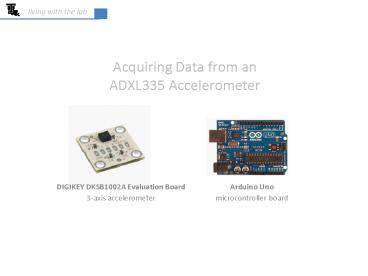Acquiring Data from an ADXL335 Accelerometer - PowerPoint PPT Presentation
1 / 7
Title:
Acquiring Data from an ADXL335 Accelerometer
Description:
living with the lab Acquiring Data from an ADXL335 Accelerometer Arduino Uno microcontroller board DIGIKEY DKSB1002A Evaluation Board 3-axis accelerometer – PowerPoint PPT presentation
Number of Views:289
Avg rating:3.0/5.0
Title: Acquiring Data from an ADXL335 Accelerometer
1
Acquiring Data from anADXL335 Accelerometer
living with the lab
2
living with the lab
DKSB1002A Evaluation Board and ADXL335
Accelerometer
- DKSB1002A is a prototyping board purchased for
20 from Digikey - Screw holes for mounting board onto object of
interest - Board is 20mm square
- ADXL335 3-axis accelerometer chip
- 3-axis
- 3g
this small chip is the ADXL335 accelerometer(this
is an older model . . . they are even smaller
now)
- COM - ground
- VSS - power (we will provide 5V)
- X - acceleration in x-direction
- Y - acceleration in y-direction
- Z - acceleration in z-direction
z
x
the DKSB1002A is a board used to evaluate the
accelerometer if you were putting an
accelerometer in a device like a cell phone, you
would only use the ADXL335 chip (and maybe some
capacitors)
y
3
living with the lab
Implementing a 3-axis Accelerometer Wiring to
Arduino
- COM - ground
- VSS - power (we will provide 5V)
- X - acceleration in x-direction
- Y - acceleration in y-direction
- Z - acceleration in z-direction
4
living with the lab
Programming
void setup() Serial.begin(9600) void
loop() int xaccel analogRead(0) int
yaccel analogRead(1) int zaccel
analogRead(2) unsigned long timevar
millis() Serial.print(timevar)
Serial.print(" ") Serial.print(xaccel)
Serial.print(" ") Serial.print(yaccel)
Serial.print(" ") Serial.println(zaccel)
associates a time with each set of accelerations
5
living with the lab
Calibration
6
living with the lab
Angle Measurement
7
living with the lab
Example Application
The piezospeaker below outputs a frequency that
varies with the acceleration in the x-direction.
The equation for computing the frequency is
chosen so that the device makes an audible noise
that varies when rotating or shaking the device.
void setup()Serial.begin(9600) void
loop() int xaccel analogRead(0) int
freq 1500xaccel2 tone(7,freq)
Serial.print(xaccel) Serial.print(" ")
Serial.println(freq)































